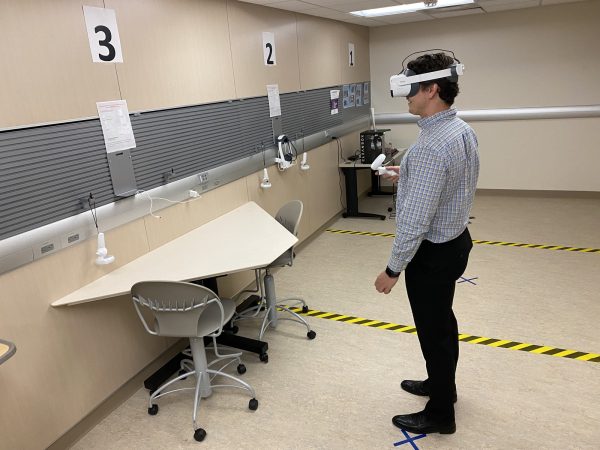
Michigan Medicine has incorporated virtual reality (VR) in its call of duty, including an app in development where multiplayer teams join a virtual room to manage cardiac emergencies. VR provides an immersive, 360-degree training environment, becoming more available and affordable in recent years. The challenge? Finding the best use case and technology solutions for the Michigan Medicine network environment. Working together, Health Information Technology Services (HITS) and the Clinical Simulation Center (CSC) identified secure, user-friendly, and affordable hardware options–including the wireless Pico 3 and Pico 4 and wired Oculus Rift and HP Omnicept VR headsets to support educational and research applications.
Dr. James Cooke, director of CSC, shared ways faculty have developed or adapted VR apps to teach skills uniquely suited to virtual reality:
Dr. Sonal Owens (Pediatric Cardiology) and colleagues adapted the Stanford Virtual Heart app to teach pediatric residents and medical students about the 3D anatomy and physiology of common pediatric congenital heart defects. She led two multi-institution education studies and demonstrated a significant improvement in 3D visuospatial understanding among learners. With funding from grateful Michigan Medicine patients and families, she now works with Lighthaus to develop the ‘Michigan Heart,’ a unique VR app focused on the concepts surrounding hypoplastic left heart syndrome and the steps in the surgical repair done at C.S. Mott Children’s Hospital Congenital Heart Center.
Drs. Scott Kelley (Family Medicine) and Dave Marzano (Obstetrics & Gynecology) recently launched required curricula for code team leadership, Advanced Cardiac Life Support, postpartum hemorrhage, and obstetric emergencies. The apps, designed by Health Scholars and adapted to Michigan Medicine care protocols, utilize a voice recognition interface allowing trainees and providers to vocalize orders with a team of VR avatars that execute those orders in real time. The experience is available to learners 24/7 in the Clinical Simulation Center-Towsley iSim space–providing unique on-demand VR-based training.
Drs. Michael Cole (Emergency Medicine), Vitaliy Popov (Department of Learning Health Sciences), and colleagues are developing a multi-user VR cardiac arrest and emergency cardiac arrhythmia management app called iREACT. Similar to multiplayer apps, teams join a “room” and work together to effectively manage a critical scenario–improving both their team performance and communication. Unique machine learning analyzes the communication, provides feedback on closed-loop communication, and provides cognitive load to the team.
“Obtaining approval for Extended Reality (XR) devices to be used on the Michigan Medicine enterprise networks is a bit challenging from a few perspectives,” says Einor Jacobsen, Business Analyst Senior for the HITS IT Academic Engagement team. Many existing platforms aren’t designed for “the most basic” enterprise networking technical or security requirements.
To address this, the collaboration worked with the Unique Device Equipment Workgroup (UDEW) and HITS networking, reviewing and selecting platforms suitable for the complex environment. The absence of a Network Access Control category or support team for these devices was remedied through funding provided by the Medical School.
Rodney Nelson, Patrick Levitre, and Rob Heller from the HITS Academic Devices team played a crucial role in supporting the newly created Educational Devices category. They ensured that devices were inventoried, onboarded, and met necessary technical standards. Working in partnership with Information Assurance, they implemented appropriate security measures for each use case.
Jim Auge and Erik Alderink in the CSC brought their expertise in VR, Michigan Medicine networks, and HITS processes to all educational programs across the institution.
“Groups that have reached out to us wanting to employ XR are eager to implement solutions utilizing the technology,” says Einor. “I think many people may still see this as a bleeding-edge technology, but what we’re seeing are hardware platforms that are maturing and content creation happening at all levels that integrate directly with the curriculum.”
